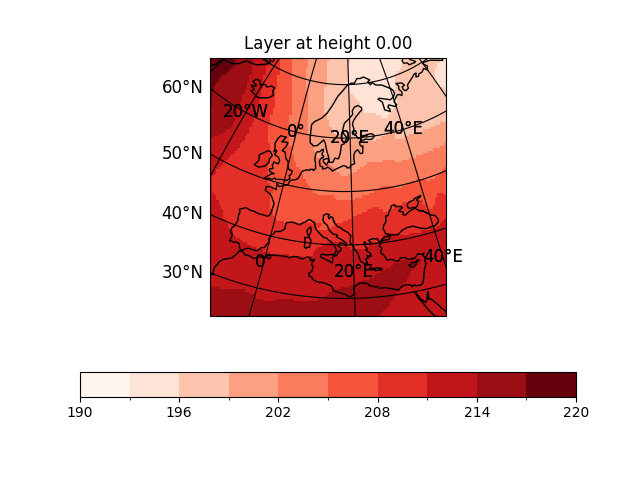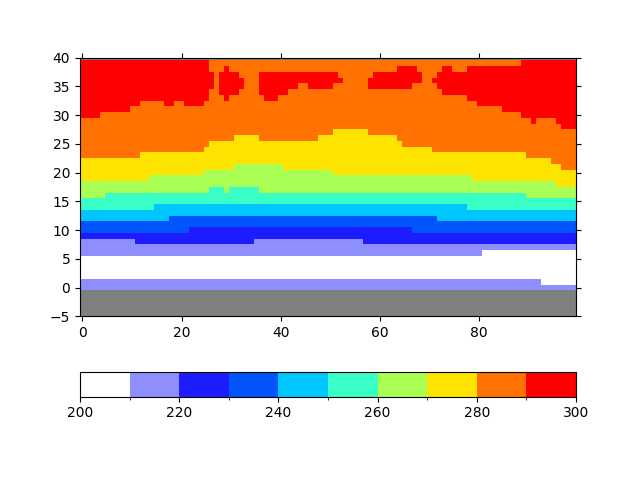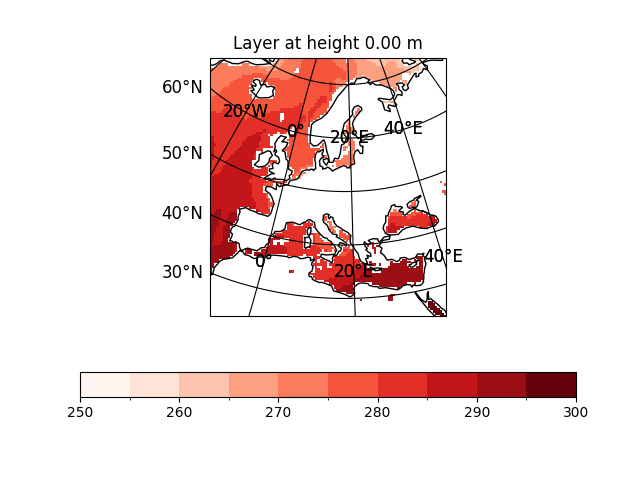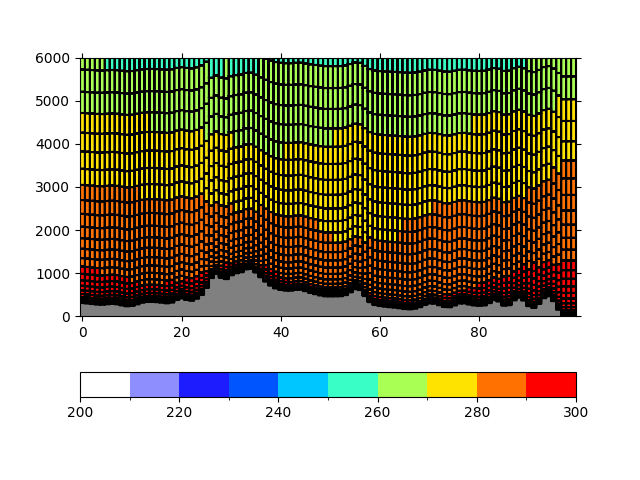Usage
Once installed, the plotmethods are available via the standard psyplot.project.plot project plotter.
Warning
We are working on a better user documentation of psy-transect. But this should hopefully give you an initial idea about the possibilities.
The example that is presented here is taken from
Sommer, P. S. Using psyplot for visualizing unstructured data and vertical transects [Computer software]. https://github.com/Chilipp/psyplot-KS-Seminar-20240201
Standard COSMO-CLM grid
We can use the horizontal_maptransect plotter for
visualizing a horizontal map transect. In this example, we use a model output
of the COSMO-CLM model and display horizontal and vertical map transects.
The file T.nc is here available for download.
In [1]: import psyplot.project as psy
In [2]: temperature_ds = psy.open_dataset("data/T.nc")
...: temperature_ds
...:
Out[2]:
<xarray.Dataset> Size: 2MB
Dimensions: (time: 1, level: 40, rlat: 111, rlon: 101, bnds: 2)
Coordinates:
lat (rlat, rlon) float32 45kB ...
lon (rlat, rlon) float32 45kB ...
* rlat (rlat) float32 444B -24.09 -23.65 -23.21 ... 23.43 23.87 24.31
* rlon (rlon) float32 404B -25.13 -24.69 -24.25 ... 17.99 18.43 18.87
rotated_pole |S1 1B ...
* time (time) datetime64[ns] 8B 1983-12-01T21:00:00
time_bnds (time, bnds) datetime64[ns] 16B ...
Dimensions without coordinates: level, bnds
Data variables:
T (time, level, rlat, rlon) float32 2MB ...
Attributes:
title: Europe 0.44 Starter Package subchain
source: CCLM: /work/gg0302/g266006/cclm-sp-v3.1.1/src/cclm/bin/c...
experiment_id: tst001
realization: 1
Conventions: CF-1.4
conventionsURL: http://www.cfconventions.org/
contact: burkhardt.rockel@hzg.de
references: http://www.clm-community.eu/
creation_date: 2019-06-29 18:32:13
history: Mon Feb 3 13:37:38 2020: ncks -v T 1983_12/out01/lffd19...
NCO: netCDF Operators version 4.7.5 (Homepage = http://nco.sf...
In [3]: temperature_ds.psy.plot.horizontal_maptransect(
...: name="T",
...: transect=0,
...: cmap="Reds",
...: title="Layer at height %(transect)1.2f",
...: )
...:
Out[3]: psyplot.project.Project([ arr0: 3-dim DataArray of T, with (level, rlat, rlon)=(40, 111, 101), rotated_pole=b'', time=1983-12-01T21:00:00])

We can combine this with a vertical map transect along a given path:
In [4]: temperature_ds.psy.plot.vertical_maptransect(
...: name="T",
...: plot="poly",
...: background="0.5",
...: transform="cyl",
...: xlim="minmax",
...: )
...:
Out[4]: psyplot.project.Project([ arr1: 3-dim DataArray of T, with (level, rlat, rlon)=(40, 111, 101), rotated_pole=b'', time=1983-12-01T21:00:00])

Vertical level information
The vertical level information in such a climate model is usually given in
bar. This information is not very helpful for most of the people, therefore
psy-transect implements a methodology, to merge the vertical information
into the data and generate a CF-conform representation of the orography. For
COSMO-CLM, this information is stored in the file with the rather cryptic name
lffd1980010100c.nc.
In [5]: from psy_transect import utils
In [6]: orography = psy.open_dataset("data/lffd1980010100c.nc").psy.HHL.psy[0]
In [7]: new_ds = utils.mesh_to_cf_bounds(
...: orography, "level1", "level", temperature_ds
...: )
...:
In [8]: new_ds.psy.plot.horizontal_maptransect(
...: name="T",
...: transect=0,
...: cmap="Reds",
...: title="Layer at height %(transect)1.2f m",
...: )
...:
Out[8]: psyplot.project.Project([ arr2: 3-dim DataArray of T, with (level, rlat, rlon)=(40, 111, 101), rotated_pole=b'', time=1983-12-01T21:00:00])
In [9]: new_ds.psy.plot.vertical_maptransect(
...: name="T",
...: plot="poly",
...: background="0.5",
...: datagrid="k-",
...: transform="cyl",
...: xlim="minmax",
...: ylim=(0, 6000),
...: yticks=np.linspace(0, 6000, 7),
...: )
...:
Out[9]: psyplot.project.Project([ arr3: 3-dim DataArray of T, with (level, rlat, rlon)=(40, 111, 101), rotated_pole=b'', time=1983-12-01T21:00:00])


As you can see in this plot, we are able to visualize the exact orography of the model, without the need of any interpolation.
Interactive exploratory data analysis
One important aspect for transects is the interactive usage. We want to be able
to connect multiple plots and visualize the vertical transect along a line that
we draw. psy-transect has implemented some widgets (that we cannot
demonstrate in this static documentation). You can activate it via
p1, p2 = psy.gcp(True).plotters
p1.connect_ax(p2)
p2.connect_ax(p1)